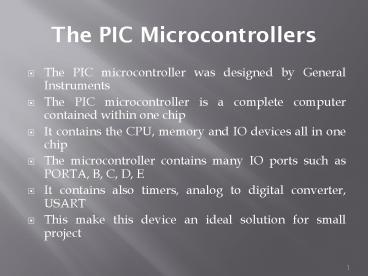The PIC Microcontrollers PowerPoint PPT Presentation
1 / 21
Title: The PIC Microcontrollers
1
The PIC Microcontrollers
- The PIC microcontroller was designed by General
Instruments - The PIC microcontroller is a complete computer
contained within one chip - It contains the CPU, memory and IO devices all in
one chip - The microcontroller contains many IO ports such
as PORTA, B, C, D, E - It contains also timers, analog to digital
converter, USART - This make this device an ideal solution for small
project
1
2
MEMORY ORGANIZATION
- There are three memory blocks in each of the
PIC16F87A devices - The program memory
- The data memory
- Stack memory
- The program memory and data memory have separate
buses which allows concurrent access
2
3
Program Memory Organization
- The PIC microcontroller contains many internal
registers to control its operation - One of these registers is the program counter
- The program counter is 13-bits wide in the
16F877A microcontrollers - This limits the program memory space to 2138k
words14 bits of flash program memory - When the microprocessor is first powered up it
starts execution at memory location 0000H - When an interrupt occurs the microprocessor goes
to memory location 0004H
3
4
(No Transcript)
5
Data Memory Organization
- The data memory is partitioned into multiple
banks which contains - The General Purpose Registers
- The Special Function Registers
5
6
Data Memory Organization
- A given bank is selected by bits RP1 (Statuslt6gt)
and RP0 (Statuslt5gt) according to the table shown
below - These two bits are located in the status register
which is equivalent to the flag register found in
the 8086
6
7
7
8
SPECIAL FUNCTION REGISTERS
- The Special Function Registers are registers used
by the CPU and peripheral modules for controlling
the desired operation of the device - These registers are shown in the attached sheets
- The most important registers will be discussed
next
9
(No Transcript)
10
(No Transcript)
11
(No Transcript)
12
Status Register
- The Status register contains the flag bits, reset
status and the bank select bits for data memory
13
OPTION_REG Register
- This register contains various control bits to
configure - the TMR0 prescaler/WDT postscaler (single
assignable - register known also as the prescaler), the
external - INT interrupt, TMR0 and the weak pull-ups on PORTB
14
(No Transcript)
15
INTCON Register
- This register is responsible controlling hardware
interrupts - The GIE (bit 7) is responsible for enable or
disable of all interrupts in the system - If GIE is 1 then all interrupts will be enabled
otherwise all interrupts will be disabled - A complete description of these interrupts will
be provided in the next slide
16
(No Transcript)
17
PIE1 Register
- The PIE1 register contains the individual
enable/disable bits for the peripheral interrupts - Peripherals are
- the analog to digital converter
- USART receiver
- USART transmitter
- Synchronous Serial Port
- Timer1
- Timer2
18
(No Transcript)
19
PIR1 Register
- When an interrupt is generated, it is important
to know which one of the above mentioned
peripherals generates the interrupt - This can be done by inspecting the state of the
PIR1 register which contains several flag bits
corresponds to each peripheral - If an interrupt occurs, then the program can test
the flags located in this register to determine
which device generated the interrupt - A complete explanation for this register is
provided in the next slide
20
(No Transcript)
21
PCON Register
- The Power Control (PCON) register contains flag
bits to allow differentiation between a Power-on
Reset (POR), a Brown-out Reset (BOR), a Watchdog
Reset (WDT) and an external MCLR Reset

